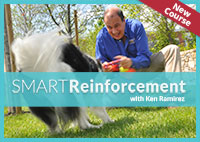What I am going to present to you is my own case study about my golden retriever, Benjamin. It was through Ben that I met Karen Pryor and, thus, found some of the most effective ways to deal with aggression and fear-based behavior in dogs.
Training Theory
"NRMs" No Reward Markers
By Melissa Alexander on 07/01/2003Humans are notoriously verbal creatures. We love to talk, and we do so automatically, even when the person we're talking to doesn't speak our language, can't hear what we're saying, or even when the "person" isn't a person at all.
How to Motivate Yourself to Train or Exercise Your Dog—Or Do Practically Anything Else!
By Aidan Bindoff on 01/03/2022Psst! Do you want to know the secret to getting things done?
Do you feel guilty about not walking your dog every day? Or not training as often as you should, or even not training when you really need to?
Click and Play: Using Play as a Reinforcer
By Angelica Steinker on 04/03/2019Dogs smile. Just like people, dogs pull the corners of their mouths up high toward their eyes, partially open their mouths, and smile. In 1872, Darwin wrote of the universality of facial expressions in The Expressions of Emotions in Man and Animals. Roughly 130 years later, Dr. Patricia McConnell authored For the Love of a Dog in which she compared human and dog facial expressions using the methods developed by Paul Ekman, the world's leading scientist on the topic. The truth is out: dogs smile, and, of course, experience emotions.
Are You Clicker Training, or Training with a Clicker?
By Kathy Sdao on 05/18/2016I began teaching people how to clicker train their dogs in 1996. At that time, most pet owners had never heard of clicker training and few class instructors took it seriously. Mine was the only advertisement in the local Yellow Pages that mentioned the word "clicker." I had to persuade students to even try this novel gadget.
A decade later, clickers are now common in dog training classes. But, I suggest, clicker training still is not.






